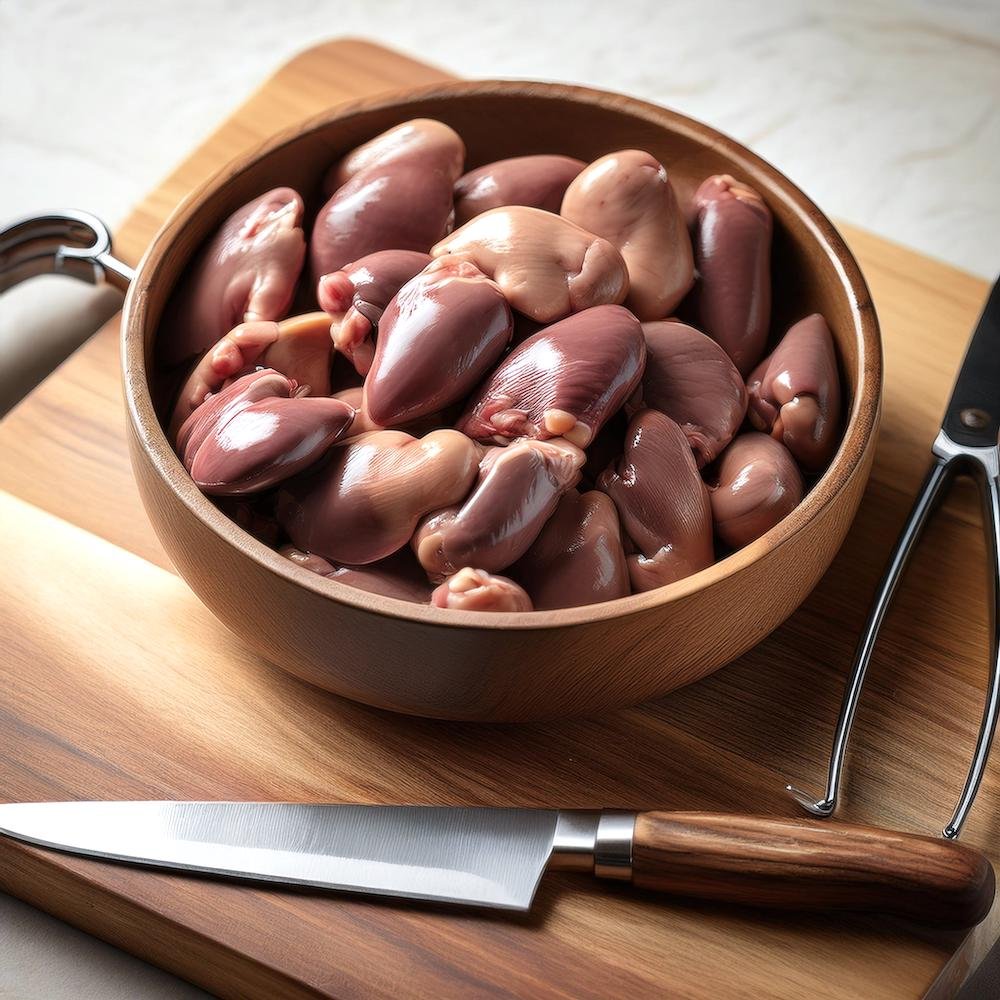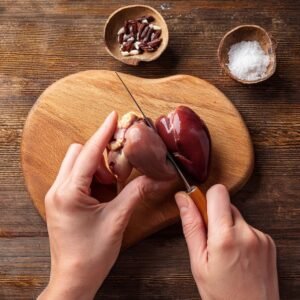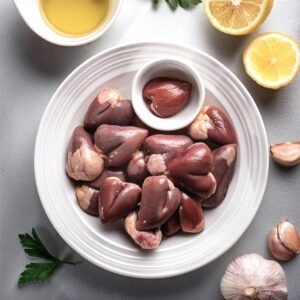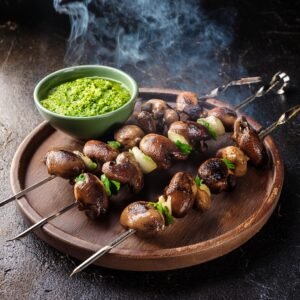Do chicken hearts need to be cleaned? Chicken hearts are a flavorful and nutrient-rich ingredient used in many cuisines around the world. However, to fully enjoy their taste and texture, it’s essential to clean them properly before cooking. Cleaning chicken hearts removes impurities, enhances their flavor, and ensures a better overall dining experience.
In this article, we’ll explore why cleaning chicken hearts is necessary, how to do it step-by-step, and how proper preparation can elevate your chicken heart recipes. Whether you’re a first-time cook or a seasoned chef, understanding this process is key to making the most of this versatile ingredient.
Why Cleaning Chicken Hearts Is Necessary
Cleaning chicken hearts is a crucial step that affects their flavor, texture, and presentation. Here’s why you shouldn’t skip this important process:
1. Removing Blood and Impurities
- Why It’s Important: Chicken hearts often come with residual blood inside the chambers, which can have a metallic or unpleasant taste if not removed.
- The Result: Cleaning eliminates these impurities, ensuring a fresher and more palatable flavor in your dishes.
2. Trimming Connective Tissues and Fat
- Why It’s Important: Chicken hearts may have excess fat, connective tissue, or blood vessels attached, which can make them chewy or tough when cooked.
- The Result: Removing these parts improves the texture and ensures even cooking.
3. Enhancing Flavor and Presentation
- Why It’s Important: A cleaned chicken heart absorbs marinades and seasonings better, enhancing its flavor profile.
- The Result: Cleaner, trimmed hearts not only taste better but also look more appealing when served.
4. Ensuring Food Safety
- Why It’s Important: Cleaning removes any potential contaminants, such as surface bacteria or residue from packaging.
- The Result: Safer, healthier meals for you and your family.
Pro Tip: Make Cleaning Part of Your Preparation Routine
Incorporate cleaning chicken hearts into your meal prep to save time and ensure all your ingredients are ready to cook.
Step-by-Step Guide to Cleaning Chicken Hearts
Cleaning chicken hearts is a straightforward process that ensures they’re ready to cook and taste their best. Follow these steps to clean chicken hearts like a pro:
1. Rinse Under Cold Water
Why It’s Important
- Rinsing removes surface blood and any debris from the packaging.
How to Do It
- Place the chicken hearts in a colander or large bowl.
- Run cold water over them, stirring gently to ensure all sides are rinsed.
- Drain and proceed to the next step.
2. Trim Excess Fat and Vessels
Why It’s Important
- Removing fat and connective tissue improves the texture and ensures even cooking.
How to Do It
- Use a sharp knife or kitchen scissors for precision.
- Inspect each chicken heart and locate any visible fat or attached blood vessels.
- Trim away these parts, leaving just the clean heart muscle.
3. Check the Interior Chambers
Why It’s Important
- Residual blood inside the heart chambers can leave a metallic taste.
How to Do It
- Cut larger chicken hearts in half lengthwise to expose the interior.
- Rinse again under cold water to remove any clotted blood.
- For smaller hearts, gently press them to squeeze out any trapped blood.
4. Optional Soaking Methods
Why It’s Important
- Soaking helps remove lingering impurities and can tenderize the hearts.
How to Do It
- Prepare a soaking solution with one of the following:
- Vinegar Water: Mix 1–2 tablespoons of vinegar with a bowl of cold water.
- Salt Water: Dissolve 1 teaspoon of salt in cold water.
- Submerge the cleaned chicken hearts and let them soak for 10–15 minutes.
- Drain and pat dry before cooking.
5. Dry the Hearts
Why It’s Important
- Drying ensures a better sear and prevents splattering during cooking.
How to Do It
- Lay the cleaned chicken hearts on a clean kitchen towel or paper towels.
- Pat them dry, removing any excess moisture.
Pro Tip: Batch Cleaning for Convenience
- Clean all your chicken hearts at once and store them in an airtight container in the refrigerator for up to 2 days or freeze for longer storage.
Tools and Techniques for Cleaning Chicken Hearts
Cleaning chicken hearts is simple with the right tools and techniques. Using the proper equipment makes the process faster, safer, and more efficient. Here’s what you’ll need and how to get the job done:
1. Essential Tools for Cleaning Chicken Hearts
1.1. Sharp Knife
- Why You Need It: A small, sharp knife allows for precise trimming of fat, connective tissue, and blood vessels.
- Recommended Type: A paring knife or boning knife is ideal for small cuts and delicate work.
1.2. Kitchen Scissors
- Why You Need It: Scissors are useful for quickly snipping away larger pieces of fat or attached vessels.
- Recommended Type: Look for scissors with sharp, durable blades and an ergonomic grip.
1.3. Cutting Board
- Why You Need It: Provides a clean, stable surface for trimming chicken hearts.
- Recommended Type: Use a plastic or non-porous cutting board that’s easy to sanitize after handling raw meat.
1.4. Colander or Sieve
- Why You Need It: Helps rinse chicken hearts thoroughly under running water.
- Recommended Type: A stainless steel or plastic colander with small holes works best.
1.5. Paper Towels or Kitchen Towels
- Why You Need It: Used to pat chicken hearts dry before cooking.
- Recommended Type: Lint-free towels to avoid debris sticking to the hearts.
2. Techniques for Efficient Cleaning
2.1. Work in Small Batches
- Cleaning hearts one at a time can be tedious. Instead, work with 5–10 pieces at a time to streamline the process.
2.2. Cut Consistently
- Trim hearts to a uniform size for even cooking. Halve larger hearts and leave smaller ones whole, depending on your recipe.
2.3. Use a Soaking Bowl
- Keep a bowl of cold water nearby to rinse each heart immediately after trimming. This prevents clotted blood or fat from spreading.
2.4. Discard Waste Promptly
- Use a separate bowl or trash bag for discarded fat and tissue to keep your workspace clean and organized.
3. Cleaning Tips for Bulk Preparation
- Plan Ahead: If cooking a large quantity, clean the hearts in advance and store them in the refrigerator or freezer until needed.
- Divide Tasks: If preparing for a gathering, enlist help to divide the cleaning process for faster results.
- Label Storage: Once cleaned, store chicken hearts in airtight containers labeled with the date to ensure freshness.
Pro Tip: Safety First
- Always wash your hands, tools, and surfaces thoroughly after handling raw chicken hearts to prevent cross-contamination. Use hot, soapy water and sanitize cutting boards and knives after use.
How Cleaning Affects Flavor and Texture
Properly cleaning chicken hearts isn’t just about presentation—it also has a significant impact on their flavor and texture. Here’s how cleaning enhances these qualities and elevates your dishes:
1. Removes Gamey or Metallic Tastes
- Why It’s Important: Residual blood inside chicken hearts can cause an unpleasant metallic or gamey flavor.
- The Result: Cleaning eliminates these impurities, allowing the natural, mild, and savory flavor of the chicken hearts to shine.
2. Enhances Marinade Absorption
- Why It’s Important: Excess fat and connective tissue can block marinades from penetrating the meat.
- The Result: Trimming these parts ensures that the hearts absorb seasonings and marinades evenly, resulting in a more flavorful dish.
3. Improves Tenderness
- Why It’s Important: Untrimmed connective tissue and vessels can become tough or chewy when cooked.
- The Result: Removing these components creates a more tender and enjoyable bite.
4. Creates a Better Texture
- Why It’s Important: Cleaned chicken hearts cook evenly and retain a pleasant, consistent texture.
- The Result: This prevents rubbery or unevenly cooked pieces, ensuring a dish that’s tender and juicy.
5. Elevates Presentation
- Why It’s Important: Neatly trimmed chicken hearts look more appetizing and professional, whether served on skewers, in stews, or as a standalone dish.
- The Result: Guests or family members are more likely to enjoy a visually appealing dish.
6. Prevents Overcooking
- Why It’s Important: Fat and connective tissue take longer to cook, which can lead to unevenly cooked hearts.
- The Result: Cleaned chicken hearts cook quickly and evenly, preventing overcooked or tough pieces.
Pro Tip: Taste as You Go
After cleaning, try marinating a small batch and cooking it to test the flavor and texture. This can help you adjust seasonings and cooking times for the rest of your dish.
Cooking Chicken Hearts After Cleaning
Once you’ve cleaned your chicken hearts, they’re ready to be transformed into a delicious dish. Here are some cooking methods and recipes that highlight their flavor and texture, ensuring they shine as the star ingredient.
1. Marinating to Enhance Flavor
Why Marinate?
- Marinating helps tenderize chicken hearts and infuses them with bold flavors.
- Acidic ingredients like vinegar or citrus juice pair well with savory spices to create a balanced flavor profile.
Simple Marinade Recipe
- Ingredients:
- 3 tablespoons olive oil
- 2 cloves garlic, minced
- 1 tablespoon soy sauce
- Juice of 1 lemon
- 1 teaspoon smoked paprika
- Salt and pepper to taste
- Instructions:
- Combine all ingredients in a bowl.
- Add the cleaned chicken hearts and toss to coat.
- Cover and refrigerate for at least 30 minutes or up to 12 hours.
2. Grilling for a Smoky Finish
How to Grill Chicken Hearts
- Preheat the grill to medium-high heat.
- Thread marinated chicken hearts onto skewers.
- Grill for 2–3 minutes per side until slightly charred and cooked through.
- Serve with chimichurri sauce or a fresh side salad.
Why It Works
- Grilling creates a smoky, charred flavor that complements the tender interior of the hearts.
3. Stir-Frying for Quick and Easy Meals
How to Stir-Fry Chicken Hearts
- Heat sesame oil in a wok or skillet over high heat.
- Add the chicken hearts and stir-fry for 3–5 minutes until browned.
- Toss in soy sauce, garlic, and ginger for added flavor.
- Add vegetables like bell peppers or snap peas for a complete dish.
Why It Works
- Stir-frying locks in the natural juices while adding a crispy exterior, making it perfect for fast, flavorful meals.
4. Braising for Tenderness
How to Braise Chicken Hearts
- Sear chicken hearts in a pan with olive oil until lightly browned.
- Add aromatics like onions, garlic, and herbs.
- Pour in chicken broth or tomato sauce and simmer for 20–30 minutes until tender.
- Serve over rice or mashed potatoes.
Why It Works
- Slow cooking in a flavorful liquid results in soft, melt-in-your-mouth chicken hearts with deep, savory notes.
5. Roasting for Crispy Perfection
How to Roast Chicken Hearts
- Preheat the oven to 400°F (200°C).
- Toss chicken hearts with olive oil, salt, pepper, and your favorite spices.
- Spread them on a baking sheet and roast for 15–20 minutes, turning halfway through.
- Serve as a protein-packed snack or appetizer.
Why It Works
- Roasting produces a crispy exterior and juicy interior, making it a simple yet satisfying option.
6. Recipe Ideas to Try
- Grilled Skewers: Brazilian-style chicken hearts with lime and garlic.
- Stir-Fry: Chicken hearts with vegetables in a soy-ginger sauce.
- Hearty Stew: Eastern European-style chicken hearts with root vegetables in a savory broth.
- Crispy Bites: Fried chicken hearts with seasoned breading and dipping sauce.
Pro Tip: Taste as You Cook
Monitor cooking times closely to avoid overcooking. Chicken hearts should be tender and juicy, with an internal temperature of 165°F (74°C).
Frequently Asked Questions (FAQs)
Do you have to clean chicken hearts?
Yes, cleaning chicken hearts is necessary before cooking.
Why: Cleaning removes residual blood, connective tissue, and fat, which can affect flavor and texture.
How: Rinse under cold water, trim excess fat and vessels, and soak in vinegar or salt water if desired.
Result: Cleaned chicken hearts absorb seasonings better, taste fresher, and cook more evenly.
How do you know if chicken hearts have gone bad?
To determine if chicken hearts are spoiled, check for these signs:
Smell: A sour or foul odor indicates spoilage. Fresh chicken hearts should have a mild, neutral scent.
Appearance: Look for discoloration or a slimy surface. Fresh chicken hearts should be smooth and reddish-pink.
Touch: A sticky or excessively slimy texture signals bacterial growth and should be discarded.
Is it okay to eat a lot of chicken hearts?
Chicken hearts can be a healthy part of your diet, but moderation is key:
Benefits: They’re rich in protein, vitamins (B12, iron, zinc), and low in calories, making them a nutrient-dense choice.
Considerations: They are high in cholesterol, so consuming them in large quantities may not be suitable for individuals with cholesterol concerns.
Recommendation: Incorporate chicken hearts as part of a balanced diet, pairing them with vegetables and whole grains.
How do you know when chicken hearts are done?
Chicken hearts are done when they reach an internal temperature of 165°F (74°C) and are:
Texture: Tender and slightly firm, with no rubbery or tough spots.
Appearance: The exterior should be golden-brown (if grilled, roasted, or fried), while the interior should be uniformly cooked with no raw or pink areas.
Cooking Time: Grilled: 2–3 minutes per side.
Stir-Fried: 5–7 minutes.
Braised: 20–30 minutes for extra tenderness.
Internal links
Chicken Hearts – Provides general information about chicken hearts, their uses in recipes, and nutritional value. This could be linked when discussing the characteristics or benefits of chicken hearts.
Are Chicken Hearts Good for You? – Discusses the health benefits of consuming chicken hearts. A natural fit when discussing why people include them in their diet.
What Does a Chicken Heart Taste Like? – Focuses on the flavor profile of chicken hearts, which can be linked when describing their culinary appeal.
Are Chicken Hearts Gizzards? – Explains the distinction between chicken hearts and gizzards. Useful to clarify common misconceptions.
Thin-Sliced Chicken Breast Recipes – While focusing on a different chicken part, it might still be useful for cross-linking related chicken-based recipes.
Conclusion About Do chicken hearts need to be cleaned?
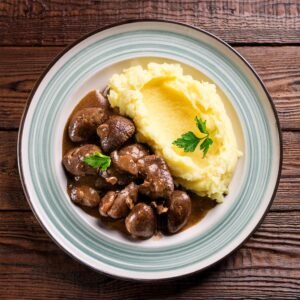
Cleaning chicken hearts is a crucial step to ensure they’re safe, flavorful, and enjoyable to eat. By removing impurities, trimming excess fat, and preparing them correctly, you can enhance their taste, texture, and appearance. Whether you’re grilling, stir-frying, braising, or roasting, properly cleaned chicken hearts are versatile and pair beautifully with a variety of flavors and cuisines.
Now that you know the importance of cleaning chicken hearts and how to do it, it’s time to put your skills to use. Try incorporating them into your favorite recipes, explore new cooking techniques, and enjoy the unique flavors they bring to your table. Share your culinary creations with friends and family, and celebrate the joy of cooking with this nutritious and delicious ingredient!
Discover more mouthwatering recipes on our Web Site ! Stay connected and get inspired by following us on Facebook, Instagram, Pinterest, and Twitter for the latest updates!
